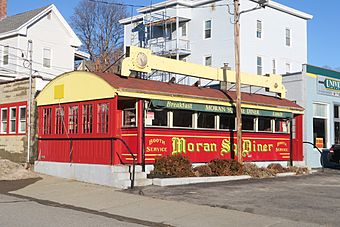Moran Square Historic District facts for kids
Quick facts for kids |
|
|
Moran Square Historic District
|
|

Moran Square Diner
|
|
| Location | E. Main, Lunenburg, and Summer Sts., Fitchburg, Massachusetts |
|---|---|
| Area | 12 acres (4.9 ha) |
| NRHP reference No. | 100001951 |
| Added to NRHP | January 4, 2018 |
The Moran Square Historic District is a special area in Fitchburg, Massachusetts. It's like a time capsule, showing how the city grew in the late 1800s and early 1900s. This district has old factories, shops, and homes.
It's located around the spot where East Main Street, Lunenburg Street, and Summer Street meet. This area became an important center for businesses and factories, a bit separate from the main downtown area. In 2018, the Moran Square Historic District was added to the National Register of Historic Places. This means it's recognized as an important place in American history.
Contents
What is the Moran Square Historic District?
The Moran Square Historic District is a collection of buildings that tell a story about Fitchburg's past. It covers about 12 acres (about 4.8 hectares) and includes 33 buildings that are important to history.
Some famous buildings in the district include the Moran Square Diner. This diner was built in 1939 by the Worcester Lunch Car Company and is still very well-preserved. There's also the Moran Block, a large building from 1908 that had both homes and shops.
How did Moran Square become important?
Fitchburg has a long history of industry, going back to the 1700s. Back then, people built mills along the Nashua River to cut wood (sawmills) and grind grain (gristmills). In the early 1800s, textile mills, which made cloth, started to appear.
The city's growth really sped up when the railroad came through in 1844. Moran Square became a busy center for businesses and factories just east of the main train station. This area thrived when Fitchburg was at its most prosperous.
Who helped Moran Square grow?
A key person in the development of Moran Square was Sylvanus Sawyer. In 1860, he built the oldest factory building in the district, located at 64 Main Street. He also built a beautiful house at 21-23 Summer Street, which you can still see today.
Sawyer's company made weapons and ammunition during the American Civil War. After the war, other companies that worked with metal also set up shop in the area. These industries did very well until the 1920s. However, they started to decline during the Great Depression and never fully recovered.
Where is the Moran Square Historic District located?
The historic district stretches out like a line. It goes south along Summer Street and Sawyer Passway from Main Street. It also has parts that reach north and northeast along Lunenburg Street and Willow Street.



